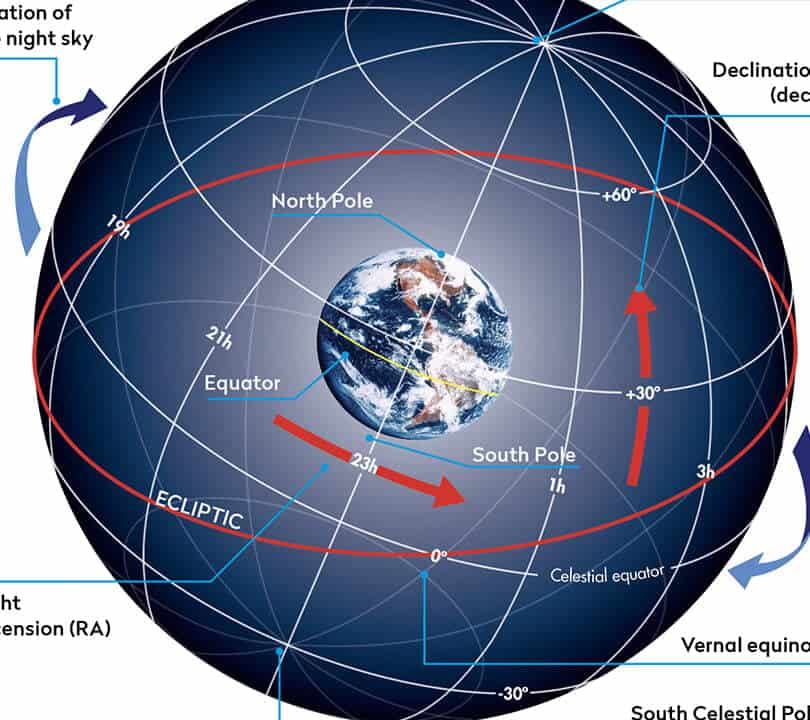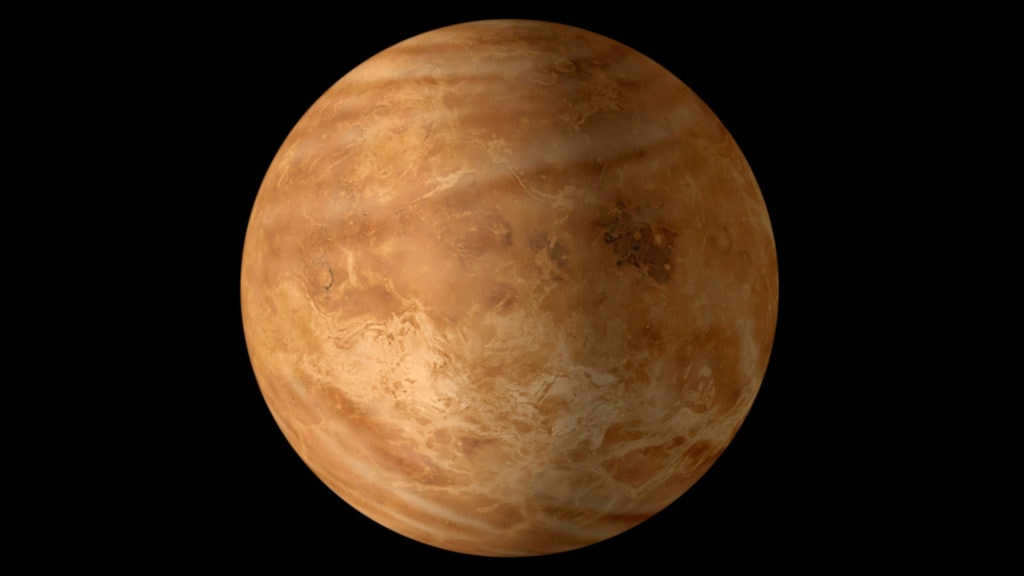
For numerous novice stargazers, Venus is a captivating celestial body to behold through a telescope due to its effortless detectability in the nocturnal expanse. Indeed, it ranks among the most radiant astral entities, second only to the Moon and the Sun!
How to locate Venus in the sky
Referred to as the “evening star” or “shepherd’s star,” Venus is easily noticeable due to its brilliant luminosity. It is the initial bright object that appears in the sky after sunset and the last one to disappear at dawn. Although it appears like a star to the naked eye, it is actually a planet. Unlike stars, which emit their own light, Venus reflects the sunlight.
When attempting to observe Venus through a telescope, there are a few considerations to bear in mind. The imaginary line that represents the Sun’s path across the sky is referred to as the ecliptic. The inclination of the ecliptic varies slightly throughout the year, reaching its highest point during the summer solstice and its lowest point during the winter solstice.
Venus is easily visible in the sky throughout the year due to its relatively close orbit to the Sun. It appears brightly every evening from January to May and then becomes the “morning star” from July until the end of the year.
Using your phone to locate Venus
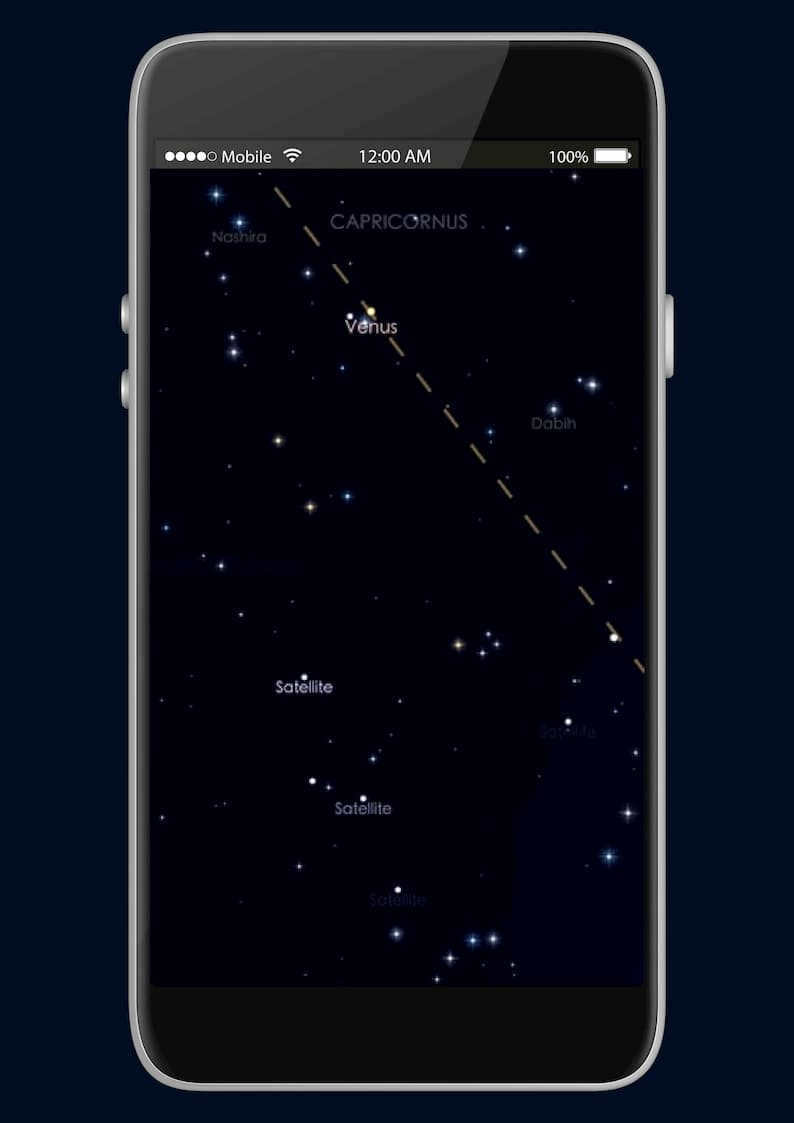
For a novice stargazer, it can be quite challenging to identify constellations in the night sky. However, thanks to modern technology, even beginners can now use their smartphones to locate celestial objects like Venus. There are several mobile astronomy applications available that can help you spot planets, stars, comets, and even satellites in just a matter of seconds.
Simply hold your phone up and smoothly scan the sky, and the app will provide you with a real-time overlay of the objects in front of you.
If you’re still having trouble locating what you’re looking for, most apps also offer a search function that can point you in the right direction.
Venus is the second closest planet to the Sun, with Earth coming in third. This arrangement makes it challenging to view Venus through a telescope in the middle of the night. Venus either precedes or follows the Sun as it traverses the sky, which means it is only visible at the beginning or end of the night.
From our perspective on Earth, the “inner” planet is always relatively close to the Sun. However, when Venus aligns perfectly between Earth and the Sun, this is known as “greatest elongation,” and in the case of Venus, it is approximately 46 degrees.
As a result, Venus is much more observable during its greatest elongation (and for several weeks afterward), as it always sets less than 3 hours after sunset or rises no earlier than 3 hours before sunrise.
At what time does Venus achieve its peak brightness?
Venus achieves its peak brightness approximately twice a year. From early January to May, Venus gradually becomes brighter, but its brightness diminishes for a few months. In mid-July, Venus’s brightness increases once again, only to fade progressively for the remainder of the year.
What is the level of difficulty in observing Venus with a beginner’s telescope?
Even with the ability to achieve 200x magnification using an eyepiece, observing the details of Venus can be challenging due to its dense atmosphere and close proximity to the sun. The planet reflects a significant amount of sunlight, resulting in a high level of glare.
This excessive glare often causes Venus to appear as a mere point of light when viewed through the telescope’s lens. However, this issue can be mitigated by attaching a lunar filter to the eyepiece.
Additionally, the quality of your observation may be impacted by your location. Pollution, airborne particles, and atmospheric turbulence can all create difficulties. As a result, some amateur astronomers choose to observe Venus during daylight hours when the brightness of the sky reduces the glare from the planet’s disk.
Caution: It is of utmost importance to exercise extreme caution when using a telescope during daylight hours. It is crucial to ensure that the sun is not within your field of vision, as it has the potential to cause severe damage to your eyes.
What is the appearance of Venus when viewed through a telescope?
Due to its position between the Earth and the Sun, Venus has a much faster orbit than our planet. Any celestial objects that are positioned closer to the Sun than the observer (us) will exhibit phases. Almost four centuries ago, Galileo made the groundbreaking discovery that Venus goes through phases similar to those of our beloved Moon, using his telescope.
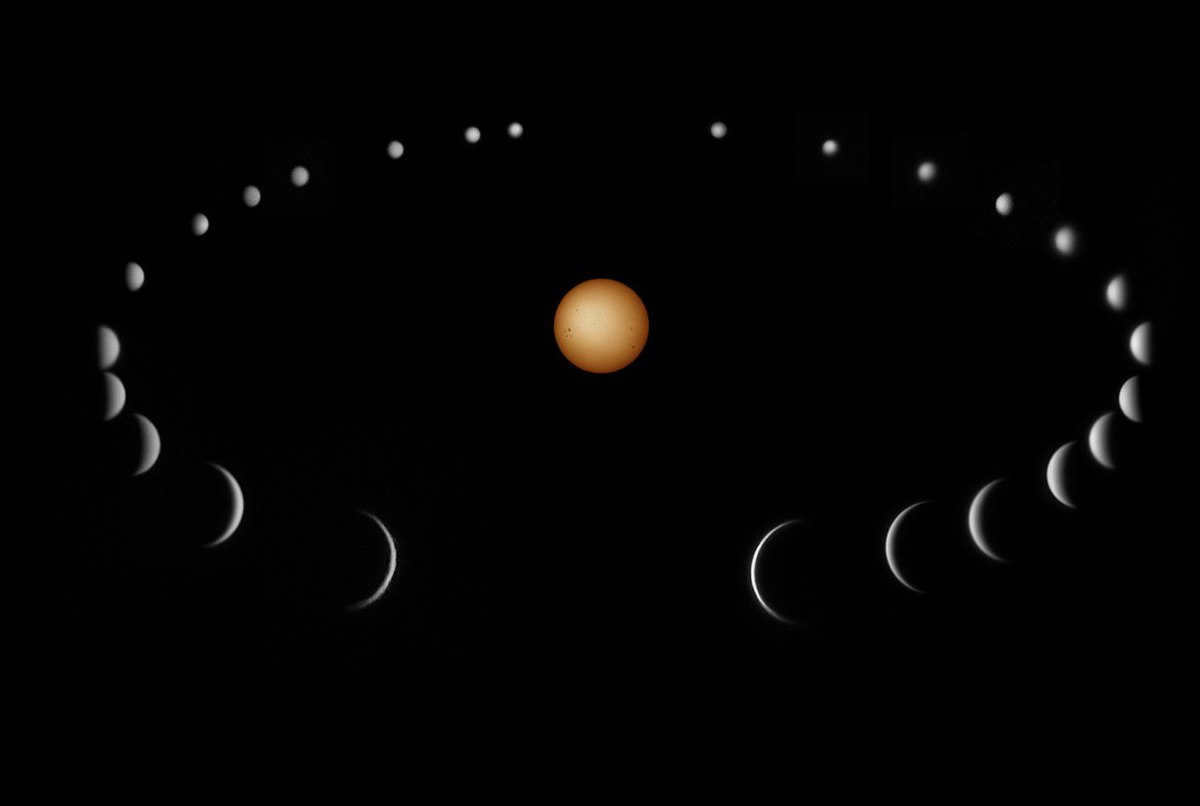
As you watch Venus month after month, you will notice a gradual transformation from being completely illuminated to having a double-hump shape, and finally to a crescent moon appearance until it completely vanishes during the New Venus phase.
Observing surface details on Venus through a telescope is challenging due to its permanent cloud cover. On the other hand, observing Jupiter through a telescope is a much more satisfying experience. Most amateur astronomers without a telescope equipped with a wide aperture or long focal length can only observe changes in Jupiter’s phase, but cannot see any additional features.
What is the method for locating planets in the sky? It can often be a challenging task. Even planets that are relatively bright, like Venus or Jupiter, can be hard to spot when they are near the Sun in the sky. How about the planetary positions in October 2020? Will they be readily observable? Will they be easily noticeable in the sky? This autumn, the visibility of the planets is quite favorable: if you are interested in observing all the main planets of our Solar System, with the exception of Mercury, they will be conveniently visible in the sky!
Mercury in October 2020
In October 2020, observing Mercury will prove to be quite challenging. At the beginning of the month, the planet can be seen in the evening sky, positioned to the left of the Sun, as it reaches its eastern elongation. However, unfortunately, in Russia, Mercury descends below the horizon in close proximity to the Sun. Consequently, it is nearly impossible to observe the planet, even during the evening twilight.
During mid-October, Mercury is completely out of sight since it is in close proximity to the Sun. However, on October 25th, it reaches a lower conjunction with our daytime luminary. This means that on that day, the planet is positioned between the Sun and Earth. Towards the end of the month, Mercury transitions to the morning sky, providing an opportunity to spot it on the 30th or 31st, mainly in the southern regions of Russia. If you reside in the Krasnodar region, Crimea, Caucasus, or the south of Primorsky Krai, you will have a chance to observe the planet as a faint star illuminated by the morning dawn, appearing very low above the horizon. To catch a glimpse, it is recommended to look towards the east-southeast approximately 45 minutes prior to sunrise. Bright Venus can be used as a reliable marker to locate the elusive Mercury.
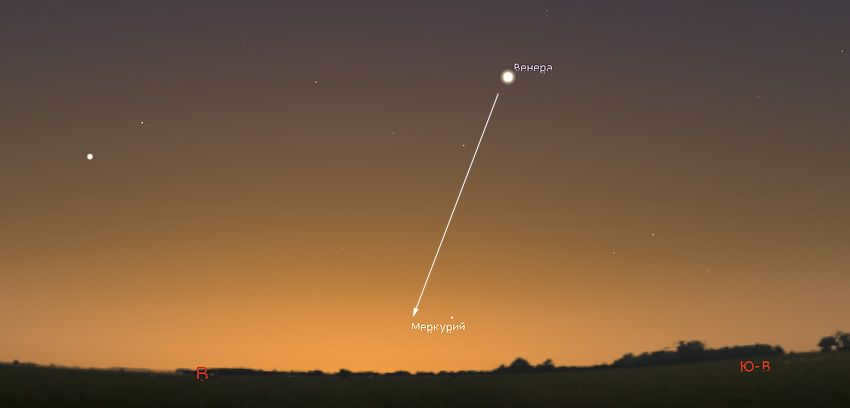
On October 31, 2020, Mercury can be seen in the morning sky. The picture depicts the view from Sochi. Image credit: Stellarium
The Presence of Venus in October 2020
Venus, known for its brightness and stunning appearance, graces the sky in October as the Morning Star. As a result, the planet is visible in the morning, emerging in the east 4 hours prior to sunrise and remaining in the same section of the sky.
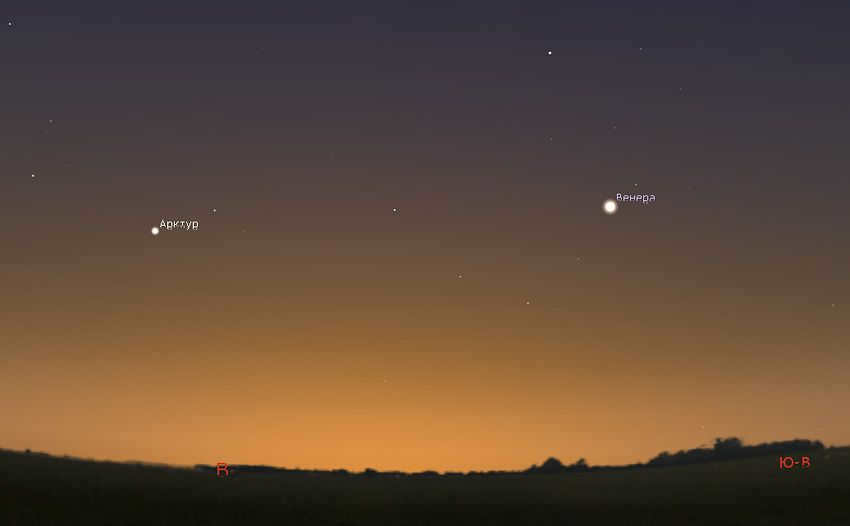

Venus can be seen against the backdrop of the morning sky during the latter part of October 2020. Image: Stellarium
In the early part of October, Venus is visible for approximately 4 hours each morning. Towards the end of the month, this visibility decreases to 3 hours. Venus can be observed clearly from all parts of Russia, including the far north.
The initial point to mention about Venus is its remarkable brightness. Specifically, it is incredibly luminous! Consequently, providing detailed instructions on how to locate it in the sky would be somewhat foolish. The only thing you need to do to observe the planet in October is to glance at the eastern sky during the early morning hours, precisely where the Sun emerges. Beginning at 5am, Venus will rise high enough above the horizon to become visible in urban areas.
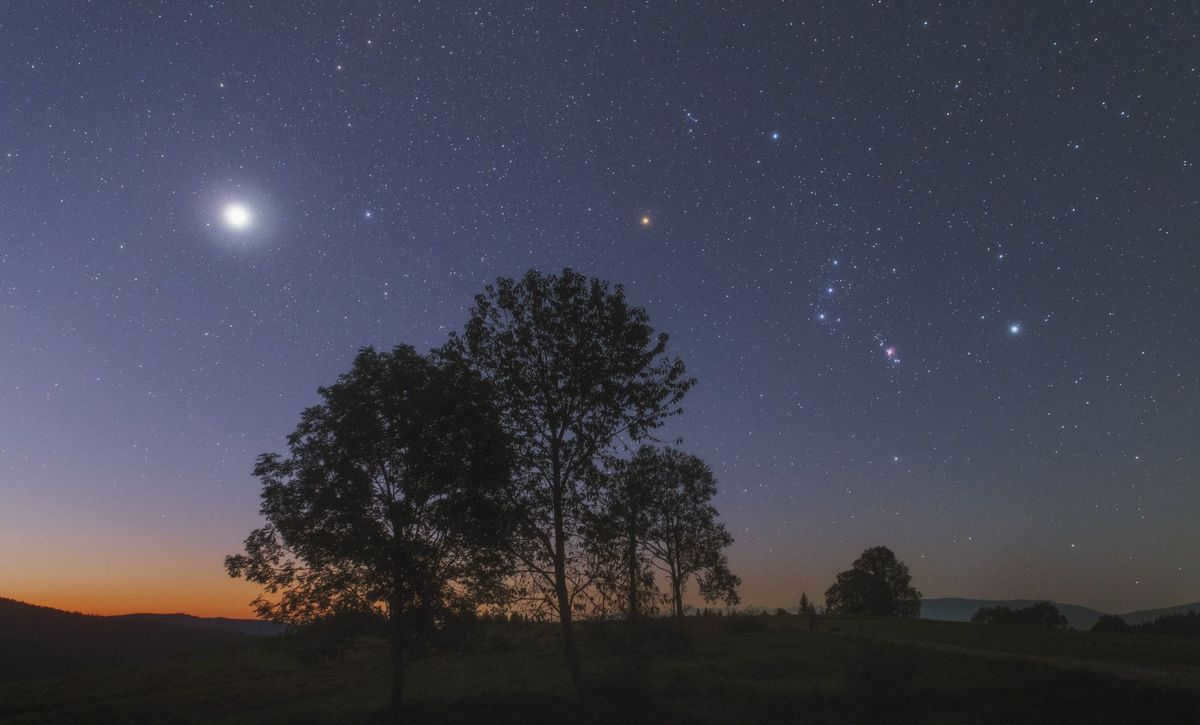

In the early morning sky, the planet Venus can be seen shining brightly alongside the constellation Orion. This captivating image was captured in late August 2020, but even in October, Venus continues to impress with its radiant presence. The planet appears as a large white star with distinctive rays, standing out against the backdrop of the dawning sky. Its brilliance is so intense that Venus can even be observed with the naked eye during daytime, although caution should be exercised to protect one’s eyes from the intense sunlight.
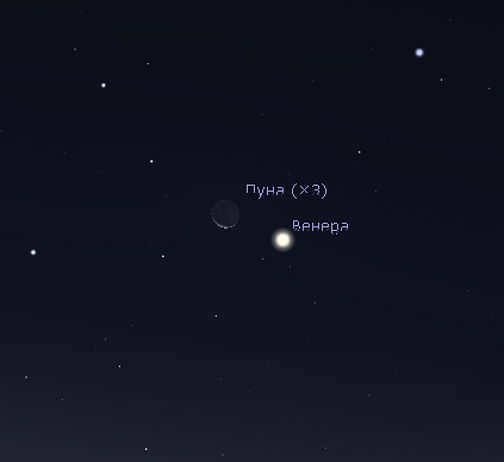
Venus and the Moon will grace the morning sky on October 14, 2020. Image: Stellarium
The early hours before dawn are Venus’ time to shine. The planet can be spotted in the eastern sky, rising high in the southeastern region just before sunrise. On October 14, the Moon will join Venus, appearing as a slender crescent. Make sure not to miss this breathtaking spectacle!
Mars in October 2020
October 2020 is a significant month for observing the planet Mars. It will be the major planet that stands out during this fall season. On the 13th of October, Mars will come into a direct alignment with the Sun. This alignment will mark a period of maximum brightness and apparent size for Mars, as it approaches its closest distance to Earth in this visibility cycle. Consequently, October presents the optimal opportunity to catch a glimpse of Mars in 2020, whether with the naked eye or through the lens of a telescope.
Throughout October, Mars will be visible in the sky during the darkest hours of the day, spanning from dusk till dawn.
During the evenings, you can spot the planet in the eastern sky. As twilight sets in, Mars starts to rise and becomes increasingly prominent after about an hour. One of the notable features of Mars is its brightness – it shines as brightly as Jupiter and is only surpassed by Venus. In fact, Mars outshines all the stars in the night sky. Moreover, its distinct reddish hue makes it easily distinguishable – it’s no wonder that Mars is often referred to as the Red Planet!
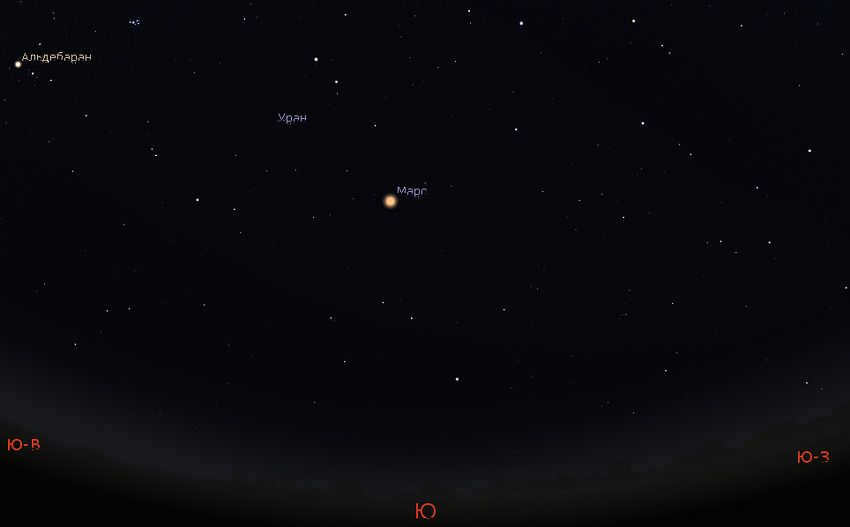

Mars stands out as the most brilliant and easily observable celestial body in the sky during the month of October, particularly around midnight. This fact is supported by the visual representation provided by Stellarium.
Throughout the night, Mars traverses the sky in sync with the entire constellation pattern, moving from east to west and creating a vast arc across the celestial sphere. This rotation of the sky is a direct reflection of the Earth’s rotation on its own axis. At the point when Mars crosses the celestial meridian in the southern part of the sky, it reaches its highest position in the arc, a moment commonly referred to as the planet’s climax. This occurrence usually takes place around midnight in the month of October. For anyone interested in observing Mars through a telescope, the few hours surrounding midnight offer the best opportunity, as the planet is positioned at its peak above the horizon during this time frame.
Mars is typically only visible in the evening or morning sky as a faint star. However, during oppositions, which occur every 2 years and 2 months, it transforms into a brilliant, fiery red planet that was associated by the ancient Greeks and Romans with the god of war. The best time to observe Mars through a telescope is near opposition, when the planet is brighter, closer to Earth, and appears larger in the telescope compared to other times.
October 2020 presents an excellent opportunity for observing Mars. Even small telescopes will reveal intriguing details, such as dazzling white polar caps composed of dry ice (frozen carbon dioxide), yellowish “continents,” and dark “seas.” Under favorable atmospheric conditions, thin, cloud-like structures resembling feathers can sometimes be seen at the edge of Mars’ disk. After observing for 20-30 minutes, the planet’s rotation becomes apparent.

When observing Mars through an amateur telescope, it is important to note that the level of detail visible may vary. This can be influenced by factors such as the Earth’s atmosphere and the observer’s experience. It should be noted that Mars currently has an apparent angular diameter of about 22 arc seconds, which is larger than its usual size. However, even at magnifications of 100x to 150x, Mars will still appear as a small orange dot. The clearer the atmosphere and the more experienced the observer, the more intricate details and color variations can be observed on the planet’s surface.
It is possible to observe Mars through a telescope from 10 pm until early morning. The planet can be found in the southeast during the late afternoon, in the southern part of the sky at night, and in the southwest in the morning.
During the night of October 2nd and 3rd, the full Moon will be in close proximity to Mars.
Jupiter’s Appearance in October 2020
In the month of October 2020, the celestial body Jupiter can be observed along with two other bright planets, namely Saturn. To catch a glimpse of them, one must look towards the evenings, when they can be seen low above the horizon in the south and southwest. However, it is important to have an unobstructed view in these directions, as the presence of houses and trees in urban areas can hinder the visibility of these planets.
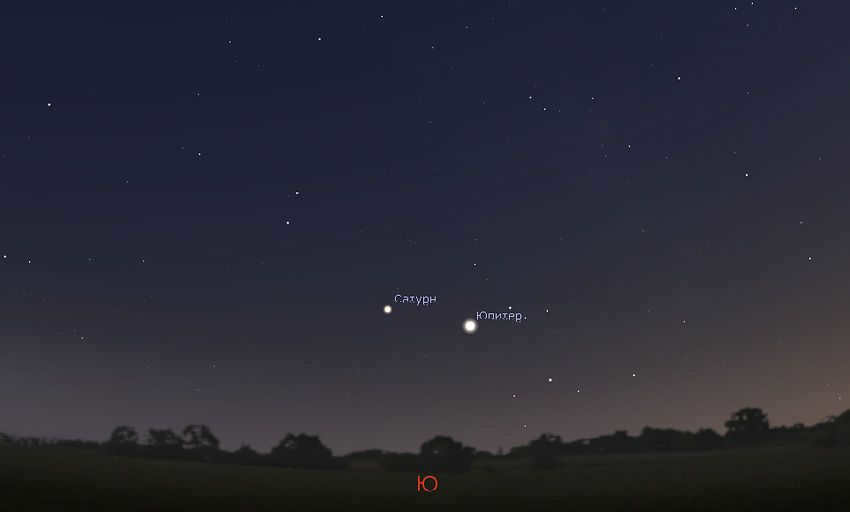

During mid-October, Jupiter can easily be spotted in the southern part of the evening sky. See the illustration below from Stellarium:
The celestial body known as Jupiter shines exceptionally bright, surpassing the brilliance of stars and rivaling that of Mars. Interestingly, during the initial hours following sunset, both Mars and Jupiter can be observed simultaneously, with Mars positioned in the east and Jupiter in the west. Take this opportunity to compare their appearances. One notable distinction between planets, such as Mars and Jupiter, and stars is their steady and serene radiance, while stars tend to flicker incessantly, primarily when near the horizon.
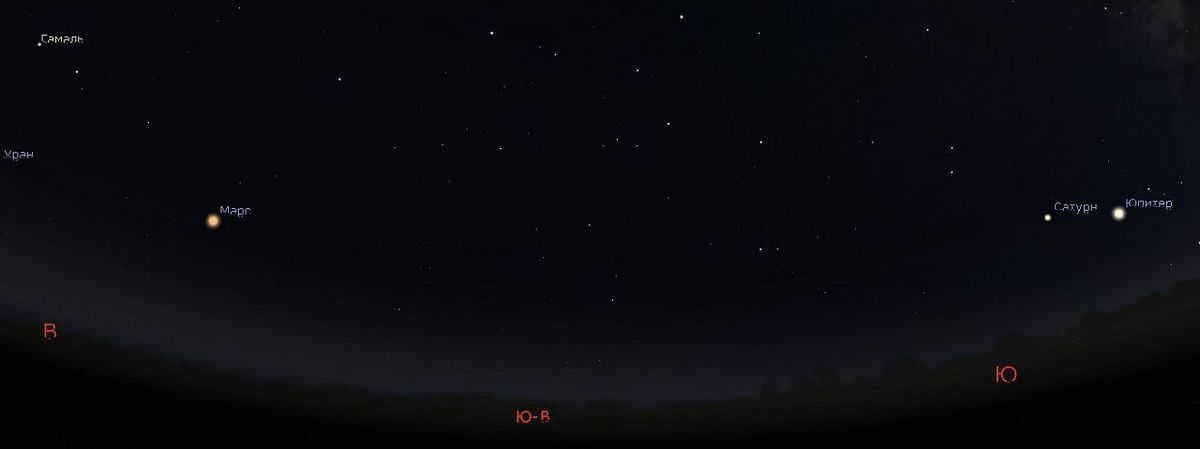
During the evenings in October 2020, two incredibly bright planets, Jupiter and Mars, can be observed in the night sky. These planets shine brightly against the backdrop of stars, creating a captivating sight. The presence of Jupiter and Mars together in the sky is a rare occurrence that should not be missed.
While Jupiter and Mars share this unique celestial moment, they also have their differences. Jupiter, for instance, has a distinct yellowish hue, setting it apart from the other planets. On the other hand, Mars stands out with its vibrant red color. Jupiter can be seen in the southern part of the sky during the evening, near its highest point, before gradually descending towards the horizon. Observers can enjoy the presence of Jupiter for approximately three hours each evening.
In contrast, Mars rises at dusk and continues to ascend higher above the horizon as the night progresses. As the evening deepens, Mars reaches a height above the horizon that is equivalent to that of Jupiter, approximately two hours after sunset. In Moscow’s sky, this height is approximately 9°, while in St. Petersburg it is only 5°. However, in the southern regions of Russia, the planets can be seen at an impressive altitude of over 15°.
The simultaneous presence of Jupiter and Mars in the night sky is a remarkable event that offers an opportunity to witness the beauty and grandeur of our solar system. Don’t miss this chance to marvel at these magnificent planets.
Jupiter observed through a telescope
When observing Jupiter through a small amateur telescope, one can observe numerous fascinating details. One of the most noticeable features is that Jupiter’s shape is not perfectly circular, but rather oval-shaped. This is due to the potent centrifugal forces near its equator, which cause the planet to be flattened at the poles. (Jupiter has a rapid rotation speed, with a day lasting only 10 hours!)
In addition, when observing Jupiter up close, one can also spot its four largest satellites using binoculars. These satellites resemble bright stars and are known as the Galilean satellites of Jupiter, named after the astronomer Galileo Galilei, who first discovered their existence. It is quite fascinating to observe the movement of these satellites over the course of a few evenings.
When the atmospheric conditions are favorable, Jupiter’s disk displays several cloud belts. These zones exhibit interesting features such as the appearance and disappearance of spots, festoons, changes in belt thickness, as well as variations in color and contrast. One particularly awe-inspiring sight is the Great Red Spot, a massive vortex that has been raging in Jupiter’s atmosphere for over 300 years. In fact, the Great Red Spot is larger than the Earth!
Unfortunately, observing these details is challenging due to Jupiter’s low position above the horizon. The turbulent atmosphere near the horizon causes air flow and blurs out subtle and low-contrast details. To fully appreciate the magnificence of Jupiter, we will have to wait a few more years.
Saturn’s Position in October 2020
In October 2020, the planet Saturn can be observed in close proximity to Jupiter in the night sky. Saturn is positioned just east of Jupiter, appearing to the left of it. The angular distance between Saturn and Jupiter is only 7 degrees, making them appear very close to each other. This celestial phenomenon can be observed throughout the year 2020.
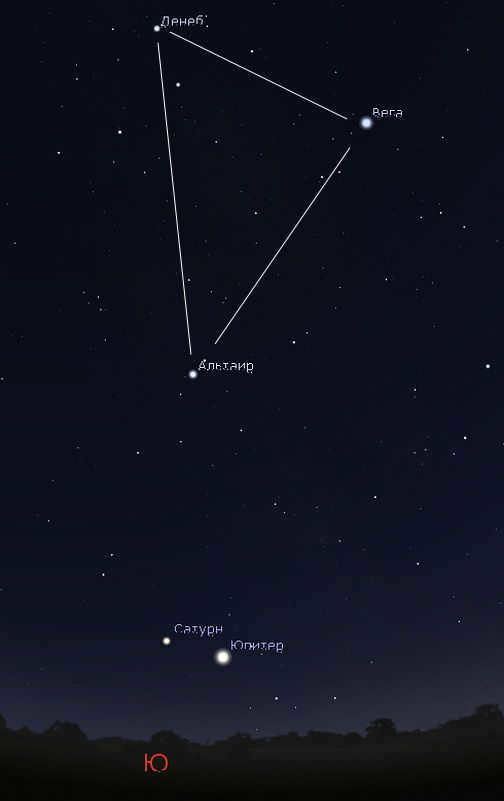
Jupiter and Saturn can be found beneath the Summer Triangle. Image: Stellarium
This is advantageous because Saturn is not as luminous as Jupiter and can easily be mistaken for a star. However, Jupiter will help you out: it acts as a great guide to Saturn. To locate the planet with rings, first locate Jupiter and then direct your attention to the star on its left, at that same height above the horizon. That’s Saturn!
Another useful reference point to find Saturn is the Summer Triangle constellation. It consists of three bright stars – Vega, Deneb, and Altair. During October evenings, this constellation can be seen high in the southern sky. And now, Saturn and Jupiter are directly below it!
Observing Saturn with a Telescope
Looking at Saturn through a telescope is an incredible experience, even for those who aren’t particularly interested in astronomy. The main attraction, of course, is the planet’s iconic rings. These rings can be clearly seen even at a modest 30x magnification. For a more detailed view, it is recommended to use a telescope with lenses larger than 100 mm and a magnification of at least 100x. With such equipment, you will even be able to spot the famous Cassini slit within the rings.
Saturn itself has a yellowish hue and is noticeably flattened at the poles. However, observing the details on the planet’s surface can be challenging due to the lack of contrast. This becomes even more difficult when Saturn is positioned low on the horizon. The same applies to the details within the planet’s rings, such as Cassini’s slit and Enke’s division, which may be virtually invisible under these conditions.
Uranus and Neptune in October 2020
The final planets in our examination are the distant Uranus and Neptune. Both planets are not visible to the naked eye. (Uranus can be seen at the edge of visibility in a very dark, clear, moonless sky, far away from city lights.) You will need binoculars at the very least to locate them in the sky. To observe the planets’ disks, a telescope with an 80mm lens or larger, and an eyepiece that provides a magnification of 100× or greater, will be necessary.
In October 2020, the planet Uranus is located in the constellation Aries, just 15 degrees east of Mars. Therefore, Mars and the two brightest stars in Aries can be a fairly good reference for locating it. Here is a map of Uranus’ vicinity.
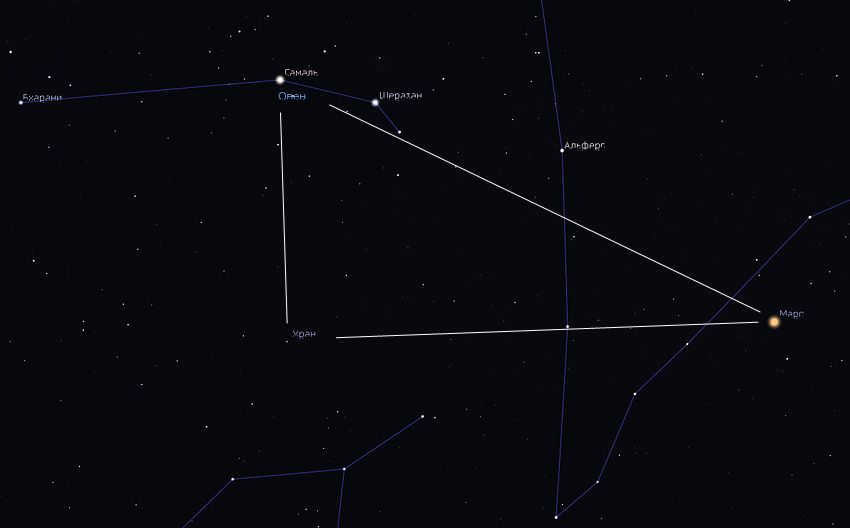

During the month of October in the year 2020, Uranus can be observed in the night sky. It forms a right-angled triangle with the brightest star in the constellation of Aries, known as Hamal, and the planet Mars. This celestial configuration can be seen with the help of a tool called Stellarium.
It is worth noting that Uranus is located approximately halfway between Mars and the Pleiades cluster, which is a remarkable collection of scattered stars. The Pleiades cluster is situated further east and resembles a small dipper in the sky.
In order to successfully locate Uranus, it is recommended to use binoculars with a wide field of view. This is because Uranus appears to be a regular star with a magnitude of 6, and it needs to be distinguished from the numerous other similarly bright stars in this part of the sky. A star chart can be used to aid in this identification process. Furthermore, Uranus has a distinct bluish hue, which can help in its recognition.
Similar to Mars, Uranus is visible in the sky during most of the nighttime hours – appearing in the eastern sky in the evening, the southern sky at night, and the southwestern sky in the morning.
Locating Neptune in the sky is even more challenging due to its dimness. In October 2020, Neptune can be found near the star φ Aquarius. Below is a map illustrating the vicinity of the planet.
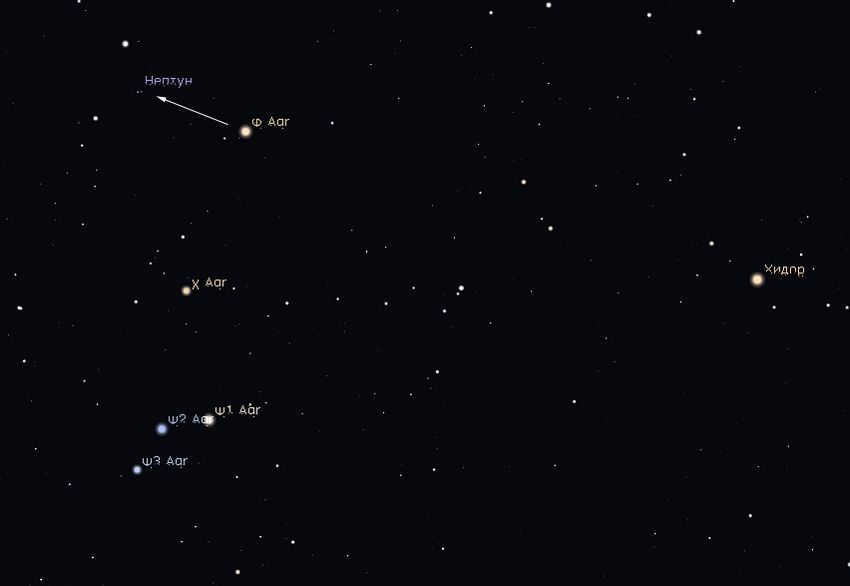

The image above shows Neptune and its surrounding area in October 2020. This image was captured using Stellarium software.
If you’re new to astronomy and are unsure how to locate celestial objects in the sky, a good starting point is to locate the planet Uranus first. Once you’ve found Uranus, you can then try to locate Neptune. To observe Neptune, the most distant planet in our solar system, you’ll need to determine the position of the constellation Aquarius in the sky. After evening twilight, look towards the southeast, between Jupiter and Mars, to find Aquarius.
Next, attempt to locate the celestial body known as the star phi Aquarius. Utilize either a star chart or a smartphone application such as Stellarium to assist in this endeavor. Subsequently, direct your telescope or binoculars towards the aforementioned star. Upon doing so, you will be able to observe Neptune positioned a mere 1.5° to the east of φ Aquarius. In fact, when peering through binoculars, the planet and star will both be visible within the same field of view. It is important to note that Neptune possesses a modest luminosity of merely 7.8 m, making it somewhat challenging to discern amidst the luminous sky of an urban environment!
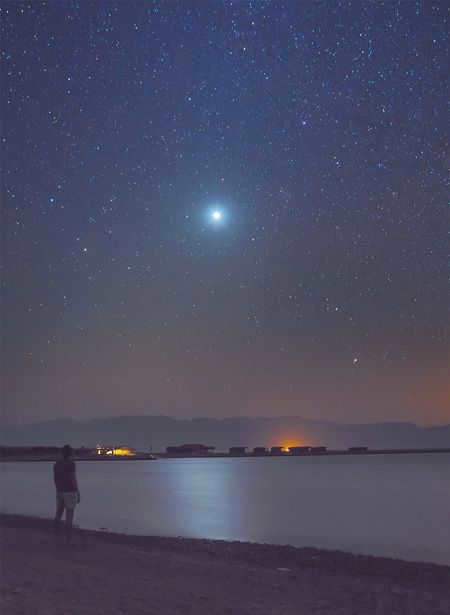
Venus is visible as it rises over the Red Sea. Photo: Ahmad Shief
Let’s summarize briefly. In October 2020, all planets except for Mercury can be seen from Russia and neighboring countries (Mercury can also be attempted to be seen in the final days of October in southern Russia).
Jupiter and Saturn can be observed low above the horizon in the evenings in the southern and southeastern parts of the sky. The planet Mars can be observed throughout the dark hours: it rises in the east in the evening, reaches its highest point above the southern horizon at night, and sets in the southwest in the morning. The planet Uranus is also visible. Neptune is situated between Jupiter and Mars and can be observed until early morning in October 2020.
October’s morning sky is most brilliant in the early hours. Venus. If you want to catch a glimpse of the stunning Morning Star, direct your gaze towards the eastern horizon.
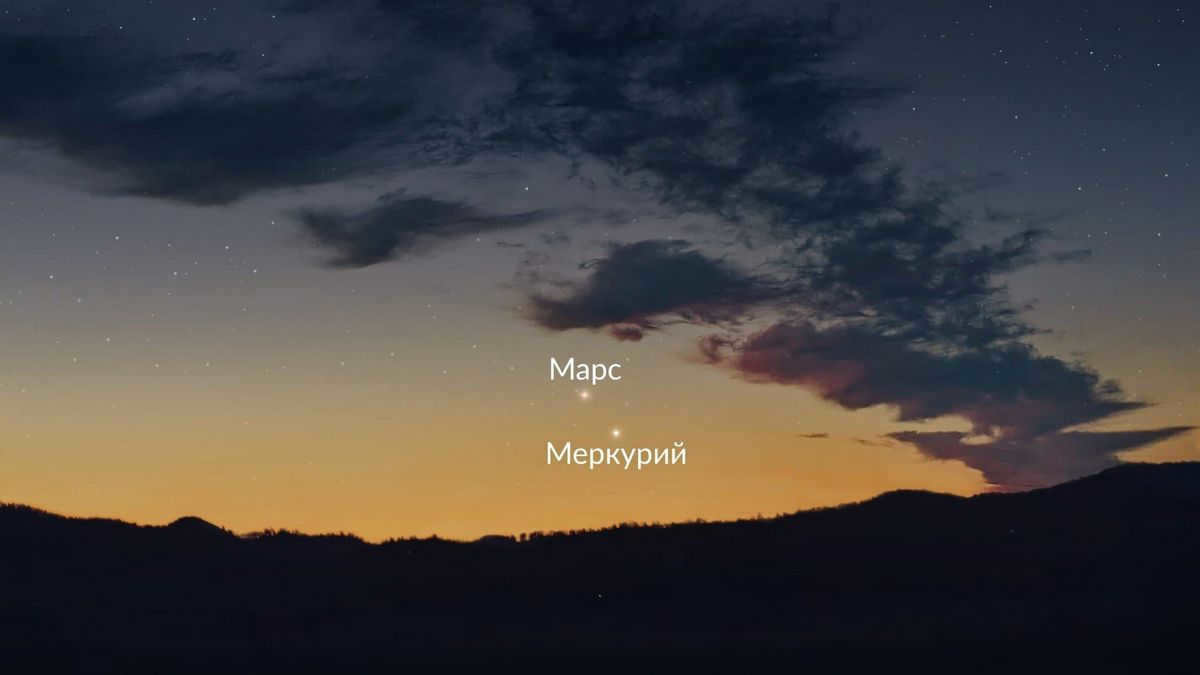
In this article, you will discover the exact time when the planets come together in the vastness of the sky and find out how to locate them effortlessly with the help of the free astronomy application Sky Tonight.
What is a planetary conjunction?
Put simply, a planetary conjunction occurs when two or more planets come close to each other in the sky. However, it’s important to note that this phenomenon is merely an optical illusion, as in reality, the planets are actually quite far apart from each other.
In astronomical terms, a conjunction takes place when celestial bodies share the same right ascension or ecliptic longitude in the sky.
Right Ascension represents a coordinate on the celestial sphere that is analogous to geographic longitude.
The ecliptic is a fictional line that marks the apparent path of the Sun across the sky throughout the year. Ecliptic longitude is measured along the ecliptic in an eastward direction, with the starting point being the location of the Sun during the March equinox.
While the first, simpler definition is more commonly used, it is not entirely accurate. It actually refers to the coming together of objects (the small angular distance between them), which usually happens shortly before or after the actual conjunction. However, it is important not to confuse the two! The coming together of objects does not necessarily indicate that they are connected.
Other celestial objects can also come together – such as natural satellites, asteroids or stars. Our article provides a list of all upcoming Moon-planet combinations so you can find out which planet is close to the Moon tonight.
Planetary Lineup
Some people mistake the terms “planetary combination” and “planetary lineup” (or “planetary parade”). A combination means that the distance between objects is smaller than usual, while a lineup means that the planets align in the same part of the sky for Earth observers.
How can I locate planets in the sky using Sky Tonight?
If you want to find planets in the sky, Sky Tonight is the perfect tool for you. Just follow these simple steps:
- Open the app and enter the name of the planet you’re interested in into the search bar.
- Click on the blue target icon next to the planet you’re searching for, and you’ll see its exact position on the sky map.
- Tap the blue compass button to see the planet’s current location in the sky. A white arrow will appear on the screen – follow it until you spot the planet. The image on the screen accurately reflects the real sky above you.
Upcoming planetary conjunctions in 2024
The most recent conjunction in 2023 took place on August 13th. However, we will have to wait until 2024 to witness the next planetary conjunction. Below, we have compiled a list of all the exciting conjunctions that will take place in 2024.
Mercury-Mars conjunction on August 13th
On August 13th at 10:02 Moscow time (07:02 GMT), there will be a conjunction between Mercury (with a sidereal magnitude of 0.4) and Mars (with a sidereal magnitude of 1.8). During this event, the two planets will be separated by a distance of 4°42′. Although they will be too far apart to be seen through a telescope, they will be visible to the naked eye. The conjunction will occur in the constellation Leo, positioned relatively high above the horizon. To catch a glimpse of this celestial event, look for the planets in the evening, approximately an hour after sunset.
January 27, 2024: Mercury-Mars
The conjunction between Mercury and Mars, which will have the smallest angular distance among the planets visible to the naked eye, is set to occur on January 27, 2024 at 18:48 Moscow time (15:48 GMT). Mercury, with a sidereal magnitude of -0.2, will come within 0°12′ of Mars, which has a sidereal magnitude of 1.3. During this time, the proximity of these two planets will be comparable to that of Jupiter and Saturn during the Grand Conjunction in 2020. Both Mercury and Mars will be observable without the aid of a telescope in the morning, shortly before sunrise. In the constellation Sagittarius, in the southeastern sky, Mars and Mercury will appear low above the horizon for observers in the Northern Hemisphere. For observers in the Southern Hemisphere, the planets will be slightly higher in the sky.
February 22, 2024: Venus-Mars.
On the 22nd of February at 12:01 Moscow time (09:01 GMT), the brilliant Venus (with a sidereal magnitude of -3.9) will come very near to the red Mars (with a sidereal magnitude of 1.3) in the constellation Capricorn. The visible gap between the two planets will be less than one degree, specifically 0°36'. Observers located in the southern latitudes should definitely take the opportunity to witness this event! Over there, Mars and Venus will appear closely aligned above the eastern horizon in the morning, just before sunrise. The view from the northern latitudes will not be as favorable – the planets will be closer to the southeastern horizon and the sun’s rays may obscure Mars. To catch a glimpse of the planets, you will need to find a location without any tall buildings or trees.
At 01:06 Moscow time on March 22 (22:06 GMT on March 21), Saturn (sidereal magnitude 1.1) and Venus (sidereal magnitude -3.8) will have a close encounter in the constellation Aquarius. This celestial event will be a rare conjunction, with the planets being only 0°18' apart. Most similar occurrences usually have a separation of 30 to 78 arc minutes. In the Southern Hemisphere, observers can look for the planets in the morning, approximately an hour before sunrise. They will appear low above the eastern horizon. On the other hand, Northern Hemisphere viewers will have a challenging time seeing this conjunction as the planets will be too close to the eastern horizon, rising just before dawn. It is unlikely for observers in northern latitudes to witness this event.
April 3, 2024: Venus-Neptune
At 13:53 Moscow time (10:53 GMT) on April 3, Venus (with a sidereal magnitude of -3.8) will come within 0°17' of Neptune (with a sidereal magnitude of 8.0) in the constellation of Pisces. While Venus will be visible to the naked eye, observing Neptune will require a telescope or binoculars with sufficient magnification. In the Northern Hemisphere, this conjunction will be challenging to observe as the planets will be too close to the eastern horizon during the morning. On the other hand, in the Southern Hemisphere, it will be slightly easier to observe this event as the planets will be higher above the eastern horizon.
April 10, 2024: Mars-Saturn
At 21:46 Moscow time (18:46 GMT) on April 10th, Mars (with a sidereal magnitude of 1.2) will come within 0°24' of Saturn (with a sidereal magnitude of 1.1) in the constellation Aquarius. Both planets will be easily visible to the naked eye. Those in the Southern Hemisphere will have a clear view of the planets high above the eastern horizon in the morning. In the Northern Hemisphere, visibility will be slightly worse as the planets will be closer to the eastern horizon and will rise just before dawn.
April 20, 2024: Jupiter-Uranus
At 10:30 Moscow time (07:30 GMT) on April 20, Jupiter (with a sidereal magnitude of -2.0) and Uranus (with a sidereal magnitude of 5.8) will come together in the constellation of Aries. Their separation will be a mere 0°31'. You can catch a glimpse of these planets in the evening, as they will be low on the western horizon shortly after sunset. This celestial event will be most visible from the Northern Hemisphere, while in the Southern Hemisphere, Jupiter and Uranus will appear very close to the horizon. To observe Uranus, bring along a pair of binoculars, as this planet is too faint to see with the naked eye, especially in brightly lit urban areas.
April 29, 2024: Mars-Neptune
At 04:01 GMT on April 29, Mars (with a sidereal magnitude of 1.1) will come extremely close to Neptune (with a sidereal magnitude of 7.9) in the constellation of Pisces. The visible separation between the two planets will only be 2'14", which is even smaller than the distance between Jupiter and Saturn during their Great conjunction in 2020 (which was 6.1 angular minutes). This Mars-Neptune conjunction may not be as visually impressive, though, as Neptune is too faint to be seen with the naked eye. However, if you have binoculars or a telescope, you can try looking towards the east in the morning to catch a glimpse of this celestial pair. Observers in the Southern Hemisphere will have a better view of the conjunction.
At 04:24 Moscow time (01:24 GMT) on May 31, Mercury (with a sidereal magnitude of -0.8) will come within 1°21' of Uranus (sidereal magnitude 5.8) in the Taurus constellation. The planets will be visible above the eastern horizon in the morning. Due to their close proximity to the Sun, this conjunction will be challenging to observe from both hemispheres. Furthermore, Uranus cannot be seen with the naked eye and will require binoculars or a telescope.
June 4, 2024: Jupiter-Mercury
At 13:04 Moscow time (10:04 GMT) on June 4, the planet Jupiter (with a sidereal magnitude of -2.0) will come within 7'04" of the planet Mercury (with a sidereal magnitude of -1.2) in the Taurus constellation. Unfortunately, due to their proximity to the Sun, this celestial event will be challenging to observe from most locations. However, if you’re feeling lucky, you can try spotting them low over the northeastern horizon in the morning.
July 15, 2024: Mars-Uranus.
At 12:22 Moscow time (09:22 GMT) on July 15, Mars (with a sidereal magnitude of 0.9) will have a very close encounter with Uranus (with a sidereal magnitude of 5.8) in the constellation Taurus. If you are in the Northern Hemisphere, you will be able to see the planets high above the eastern horizon in the morning, about an hour before sunrise. In the Southern Hemisphere, they will appear slightly lower, in a northeasterly direction. To catch a glimpse of Uranus, you will need binoculars at the very least.
August 7, 2024: Mercury-Venus.
At 20:23 Moscow time (17:23 GMT) on August 7, Mercury (with a visual magnitude of 1.8) will be positioned 5°42' away from Venus (with a sidereal magnitude of -3.8). Venus will be located in the constellation Leo, while Mercury will be found on the border between the constellations Leo and Sextant. Due to their proximity to the Sun, observing these planets may prove to be challenging. However, it is still worth attempting to catch a glimpse of them in the evening sky, particularly when they are low in the western horizon.
At 17:45 Moscow time on August 14th (14:45 GMT), the red planet Mars (sidereal magnitude 0.8) will come within just 0°18' of the bright Jupiter (sidereal magnitude -2.2). This stunning pair will be visible to the naked eye in the Taurus constellation. Taking into account the brightness of both planets, the distance between them, and their visibility, this conjunction can be considered the best of the year. In the Northern Hemisphere, Mars and Jupiter will be visible from around midnight until morning, rising high above the eastern horizon. In the Southern Hemisphere, the planets will rise in the northeast in the morning, a few hours before sunrise.
Now you have the knowledge of how and when to observe planetary conjunctions. If you enjoyed this article, please share it with your friends.
We hope you have clear skies and successful observations!
Five planets – Mercury, Venus, Mars, Jupiter, and Saturn – can be seen in the sky without any special equipment. However, there are times when they cannot be observed and binoculars or even telescopes are needed. Despite this, there are many opportunities to see them, as they are visible for extended periods of time. All you need to do is determine their location in the sky and familiarize yourself with their unique characteristics.
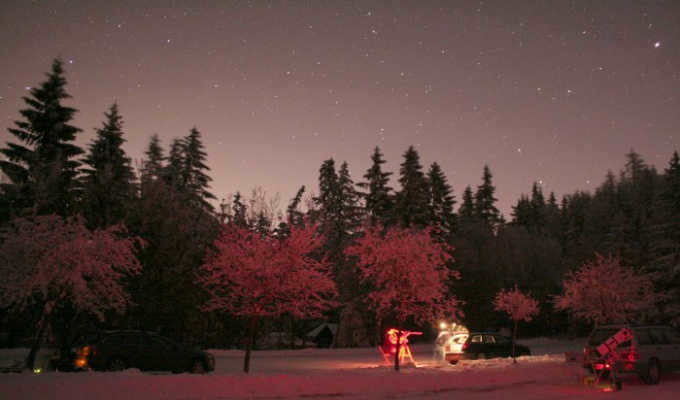

What you will require:
Steps:
1. In ancient times, when telescopes did not exist, five planets were discovered. The movement of these planets in the sky is different from the movement of the stars, allowing people to distinguish them from the millions of stars. There are two categories of planets: inner and outer planets. The inner planets, Mercury and Venus, are located closer to the Sun than the Earth. Their position in the sky remains consistently near the horizon. As a result, these two planets are referred to as the inner planets. Despite appearing to follow the Sun, Mercury and Venus can be observed with the naked eye during their maximum elongation, when they are at their furthest angular distance from the Sun. These planets can be seen in the evening shortly after sunset or in the early morning hours. Venus, in particular, is much larger and brighter than Mercury, making it easier to spot. When Venus is visible in the sky, no other star can match its brightness. Venus emits a white light and, upon closer observation with binoculars or a telescope, its phases similar to the moon can be observed. Venus can appear as a crescent, waning, or waxing. In early 2011, Venus was visible approximately three hours before dawn. It will be visible again to the naked eye starting from the end of October, this time in the evening sky in the southwest within the constellation Libra. Towards the end of the year, its brightness and visibility duration will increase. On the other hand, Mercury is predominantly visible during twilight and can be quite challenging to locate. This is why the ancients referred to it as the Almighty of Twilight. In 2011, it will be visible from the end of August for approximately a month. Initially, the planet will be visible in the morning hours within the constellation Cancer, and then it will move to the constellation Leo.
The planets are in the sky.
2. The outer planets, namely Mars, Jupiter, and Saturn, can be observed in the sky during moments of opposition, which occurs when the Earth aligns with the planet and the Sun. Among these planets, Mars shines with a maximum brightness of -2.91m, making it the second brightest object in the sky after Venus (-4m) and Jupiter (?2.94m). Mars appears as a red-orange “star” in the evening and morning, transitioning to a yellow hue during the night. In 2011, Mars will be visible in the summer and will disappear again in late November. During August, the planet will be located in the constellation of Gemini, and by September, it will move to the constellation of Cancer. Jupiter is another prominent planet in the sky, known for its brilliant appearance. While visible to the naked eye, it is especially captivating when observed through binoculars or a telescope, revealing its surrounding disk and four largest satellites. In June 2011, Jupiter will emerge in the eastern part of the sky, gradually losing brightness as it approaches the Sun. However, its brightness will begin to increase again in the fall. By the end of October, Jupiter will enter opposition, making the fall months and December the optimal time for observing the planet. Saturn, on the other hand, can be tracked with the naked eye from mid-April to early June. November is particularly favorable for observing Saturn, as it moves slowly across the sky and can be found in the constellation of Virgo every year.
Engaging in astronomical tracking is an incredibly captivating pursuit. Venus, one of the most luminous celestial bodies accessible to amateur astronomers, poses the question: how can one locate this planet in the heavens?
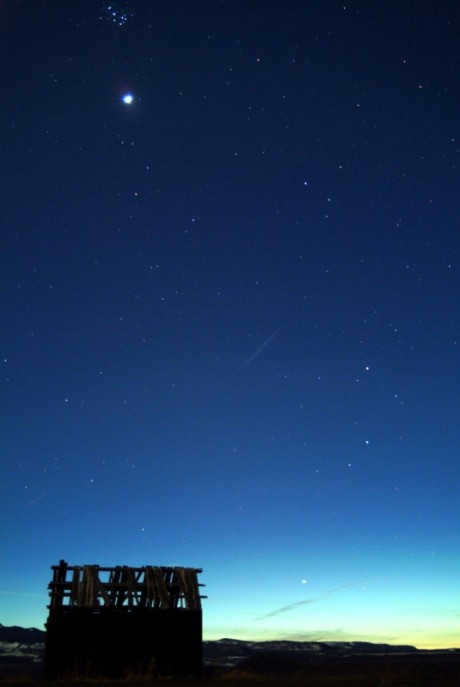

Instructions
1. Equip yourself with a telescope. Venus appears as a bright star in the sky, it can be seen with the naked eye, but for scientific observation, a telescope is necessary.
2. Venus orbits the Sun faster than Earth, so it can be observed twice a day. Choose either the morning or evening to track Venus. In the evening, Venus can be found in the west, and before sunrise, it can be seen in the east.
3. Prepare the telescope and perform the necessary calculations. You must determine the current position of the ecliptic plane, which is the path that the Sun takes across the sky. Venus, like other celestial bodies, is best observed during the elongation period when it is farthest from the Sun. The maximum angle between Venus and daylight never exceeds 47 degrees. During the day, Venus cannot be seen due to the bright background light. We can only spot it when it is at least five degrees away from the Sun.
Each planet in the Clear System is unique and generates not only scientific fascination but also a kind of friendly curiosity among astronomy enthusiasts. The planet Saturn garners attention due to its distinct rings, immense size, and numerous satellites. A high-quality telescope allows for a closer look at all of these features. However, locating Saturn in the night sky can be challenging due to its peculiar orbit around the Sun and changes in its inclination. Nevertheless, attempting to find Saturn even with a pair of regular binoculars will undoubtedly provide a great deal of enjoyment!
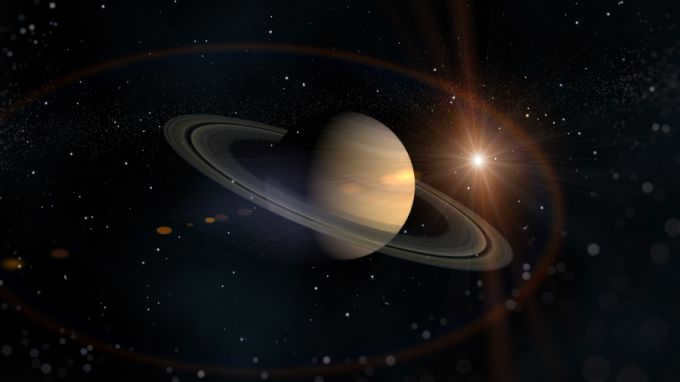

What you will need:
Instructions
1. First and foremost, ensure that when you decide to search for Saturn, it is in opposition to both Earth and the Sun. Opposition means that Earth is situated between Saturn and the Sun, resulting in Saturn being well-illuminated and easily visible from Earth. According to the Realsky website, in 2011, Saturn entered opposition on April 4th. Keep in mind that oppositions of Saturn occur annually, with a slight shift of two weeks from the previous year’s date.
2. Select a time, typically 40 minutes to 1 hour after sunset. Choose a spacious spot, preferably at a higher elevation. Search for the celestial body in the southwestern part of the dusk sky. Initially, this can be done without the aid of any optical device. The further north you are, the lower Saturn appears in the sky. Saturn is positioned above the horizon. Therefore, the southern regions of the country have an advantage in observing it.
3. Look for approximate landmarks. Saturn а. To accomplish this, you will require data on the movements of Saturn and its passage across prominent objects in the night sky – massive stars in certain constellations. Throughout the year, this information is regularly updated on specialized astronomical sources. For instance, in July 2011, Saturn enters the region of Virgo and comes very close to its gamma star, known as Porrima. This means that the star and the planet appear close to each other from the perspective of an observer on Earth, within a quarter of a degree. This rare occurrence is not only visually stunning but also serves as an excellent point of reference.
Video about the subject
Please note!
According to Realsky, July is the last significant month for observing Saturn this year. However, the opposition of Saturn will end on October 14, 2011, and it will be difficult to track it after July – we will have to wait until next year to say goodbye to the planet.
Useful Tip
Remember, the brightness of Saturn is constantly changing. This is because the planet’s rings also reflect light, and the brightness depends on the angle at which Saturn is tilted. When the rings are fully open, the planet appears brighter than when they are turned edge-on.
Mars – the planet located further from the Sun, is the fourth closest neighbor to Earth and has always been a subject of great interest for astronomers. However, in order to observe and study this celestial body, it is crucial to not only be aware of its position in space, but also take into account the most favorable time for tracking it.
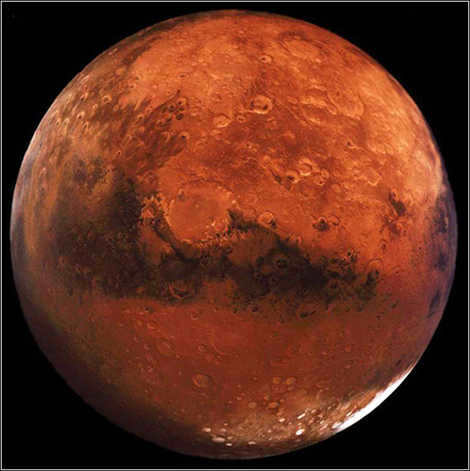

Instructions
1. The initial observers who discovered Mars in the heavens and recorded its orbit were priests from Babylon, Egypt, and Greece. It was these individuals who observed the “reddish star” moving through the constellations of Cancer and Gemini in the eastern part of the celestial sphere. Due to its distinct red-orange tint, Mars was designated as the “warrior star.” The early astronomers tracked Mars without powerful optical magnifiers. This may have been because Mars resided in a region of the sky with few stars. It could also have been due to favorable periods for observing Mars, known as Ares and Nergal in Greece, Ancient Rome, and Babylon.
2. To calculate the optimal time frame. Given that Mars has a highly elongated and elliptical orbit, with a distance that ranges from 400 to 55.75 million kilometers, it is important to take into account its motion periods. Every twenty-six months, Mars enters a favorable phase for observation. These phases are known as oppositions. Epochal oppositions occur approximately once every 15-17 years. The most significant oppositions happen once every eighty years. The most recent greatest opposition of Mars took place in 2003.
Video about Finding Saturn in the Night Sky
Looking for Saturn in the night sky can be a thrilling adventure. This planet with its iconic rings is visible to the naked eye, and with the aid of a telescope, you can not only locate Saturn but also observe its magnificent rings and, if you’re fortunate, some of its moons. The key is knowing where to direct your gaze to spot Saturn.
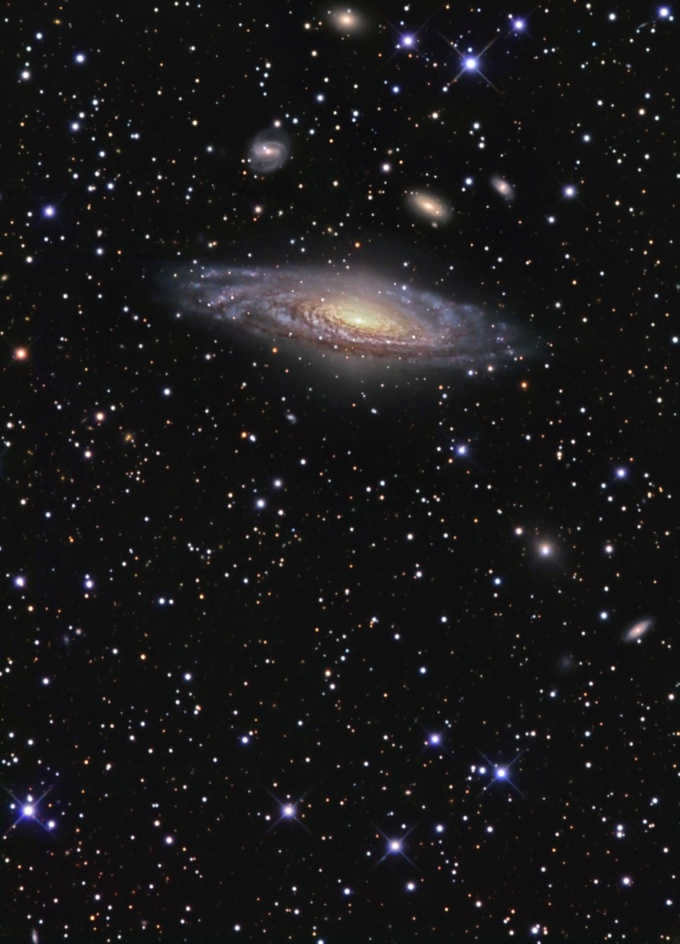

What you will need
Instructions
1. To detect Saturn, start by studying the current starry sky map. Since both Earth and Saturn are constantly moving, Saturn is not always visible at night.
2. Find an open, dark location away from city lights. You need to have a clear view of the brightest stars in order to spot Saturn.
3. Attempt to locate the ecliptic in the sky using a star chart. The ecliptic, an imaginary line that traverses the sky, can assist in finding the planets. It passes through the zodiac constellations of Aries, Taurus, Gemini, Cancer, Leo, Virgo, Libra, Scorpio, Sagittarius, Capricorn, Aquarius, and Pisces. Saturn will be situated somewhere along this line, along with various other planets that may be visible on your chosen day of Saturn discovery.
4. Keep an eye out for a brilliant yellow star corresponding to the position indicated on the chart for Saturn. Planets, when observed with the naked eye, resemble stars. The only distinction is that they do not twinkle, and the twinkling yellow star is Saturn.
5. Use binoculars or a telescope to verify your assumptions. The presence of the rings will validate your hypothesis. We have made the remarkable discovery of Saturn.
Stargazing is an incredibly enchanting and captivating pastime. However, it becomes even more intriguing when we don’t simply gaze at the night sky, but actively search for specific celestial objects within it. For instance, why not attempt to locate Jupiter among the stars?
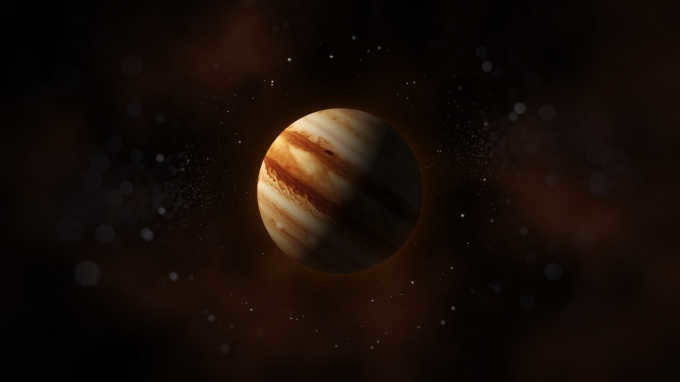
You will require
Instructions
1. Jupiter, being the largest planet in the Clear System, is quite easily observable in the sky. It holds the fourth position in terms of brightness among all celestial bodies, following the Sun, Moon, and Venus.
2. Jupiter completes one rotation on its axis in the Clear System in thirteen months. Therefore, before attempting to locate Jupiter, confirm its visibility during the current period. Jupiter remains visible for several months, with a few hours each night – before midnight and after it. To determine when Jupiter will reappear in the sky, refer to an astronomical guide. This resource will also provide information on the optimal viewing hours for observing this planet.
4. In order to locate Jupiter in the sky, you will first need to locate the constellation of Pisces. It is not very conspicuous and can be found near the constellations of Andromeda and Pegasus. The constellation of Pisces does not have any bright stars and can be quite challenging to find. It is highly recommended to use a star map to assist you in this task, as it is unlikely that you will be able to remember the positions of all the constellations without it. Jupiter moves across the constellation of Pisces, so its location changes over time.
5. It is sufficient to have a general idea of the location of Jupiter in order to find it in the sky. This planet shines brightly and is larger than the stars, so if you know where to look, you can easily distinguish Jupiter from other celestial objects.
6. Tracking Jupiter is a simple task, but it is much more enjoyable to observe this planet through a pair of binoculars or a telescope. A small telescope with a diameter of 60-90 mm will suffice, and it will allow you to see the clouds on Jupiter’s surface. Even with the lightest telescope, you will be able to witness the splendor of Jupiter and spot its four nearby satellites.
The planets are eager to be seen by everyone, as they are the closest celestial objects to us in the galaxy. With the knowledge of where to look, spotting Jupiter, Venus, and even Mars in the night sky is a breeze.
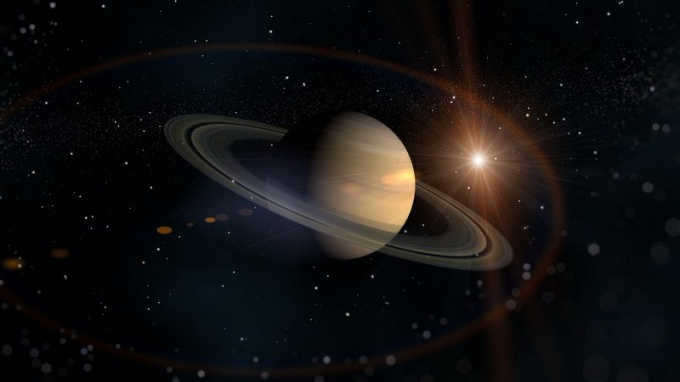
Instructions
1. Visible to the naked eye, without the use of a telescope, are the planets Saturn, Mars, Mercury, Jupiter, and Venus. While every mature person has likely seen the last two planets, this is especially true for Venus, as it is the third brightest object in the sky (after the Moon and the Sun, of course).
2. Jupiter, being the largest planet in the solar system, emits a distinct yellowish glow, making it relatively easy to spot in the night sky. It stands out quite prominently against the backdrop of white and bluish stars.
3. When Saturn and Mars are as far away from Earth as possible, they can often be mistaken for stars. Saturn is too distant, and Mars is not large enough, making them difficult to locate in the sky. However, when they are closer to Earth, they become visible. It is important to note that they cannot be found close to dawn or just after sunset; their best viewing time is during the late night.
4. The planet closest to the Sun, Mercury, is challenging to observe from Earth due to its tendency to hide in the bright sunlight. Typically, it is visible in the western part of the sky in the evenings after sunset during the spring, or in the eastern sector of the celestial dome before dawn in the fall.
5. Each of the planets moves through the twelve zodiacal constellations. It is commonly known that there are only twelve of these constellations. However, there is an additional unaccounted constellation known as Serpent, where our luminary resides during the end of autumn and the beginning of winter. Brilliant planets can be observed in this constellation during this time period. It is important to note that these planets can only be found in the zodiacal constellations, not in Orion, the Big Dipper, or Pegasus.
6. The planets in our solar system can be categorized as either outer or inner planets. The inner planets are those that are closer to the Sun than Earth, consisting of Venus and Mercury. On the other hand, all the other planets are considered outer planets. The inner planets can only be seen in the morning or evening sky, while the outer planets can be observed throughout the entire night.
Individuals are drawn to observing the celestial sky. Irrespective of the surrounding circumstances or the hardships that push us down to the brink of danger, there will always be those who choose to gaze upward. It is this very characteristic that defines our humanity.


Aspects of the celestial sky
On a clear night, stepping out into the open unveils a breathtaking panorama of the starry sky above. With a keen eye, one can observe numerous luminous dots scattered across the heavens. Among them, some are stars, others are planets, or even man-made objects launched into space. This awe-inspiring spectacle captivates us and instills a desire to delve deeper into the mysteries of the Universe.
However, the journey into scientific exploration begins with understanding the fundamentals. We perceive the starry sky as a hemisphere, and orient ourselves by identifying cardinal directions: north, south, east, west, zenith, and nadir. Locating the zenith is the simplest task as it lies directly above the observer’s head. The nadir, on the other hand, is the opposite direction and can be found beneath our feet.
The process of orienting oneself to the cardinal directions should commence by establishing the position of the north. In the Ukrainian night sky, this can be easily accomplished with the aid of the Ursa Major and Ursa Minor constellations, which bear a resemblance to buckets. It is no coincidence that the Chumaks, who journeyed to Crimea in search of salt, bestowed upon these constellations the monikers of the Big and Little Ladles.
How to locate the northern direction
Finding the north can be made easier by identifying the Big Dipper, which stands out due to its larger size. The focus should be on the two stars at the front of the “bucket”, known as Dubhe and Merak. By drawing a line through these stars in the direction from which the load would be placed on a cart, you can determine the general northward direction. If you measure approximately 5.5 distances between these two stars along this line, you can locate the “tail” of the Little Bear constellation. At the end of this tail lies Polaris, also known as the North Star. However, it’s important to note that this method is not effective in the Southern Hemisphere, as Polaris does not appear above the horizon in that region during our current era.
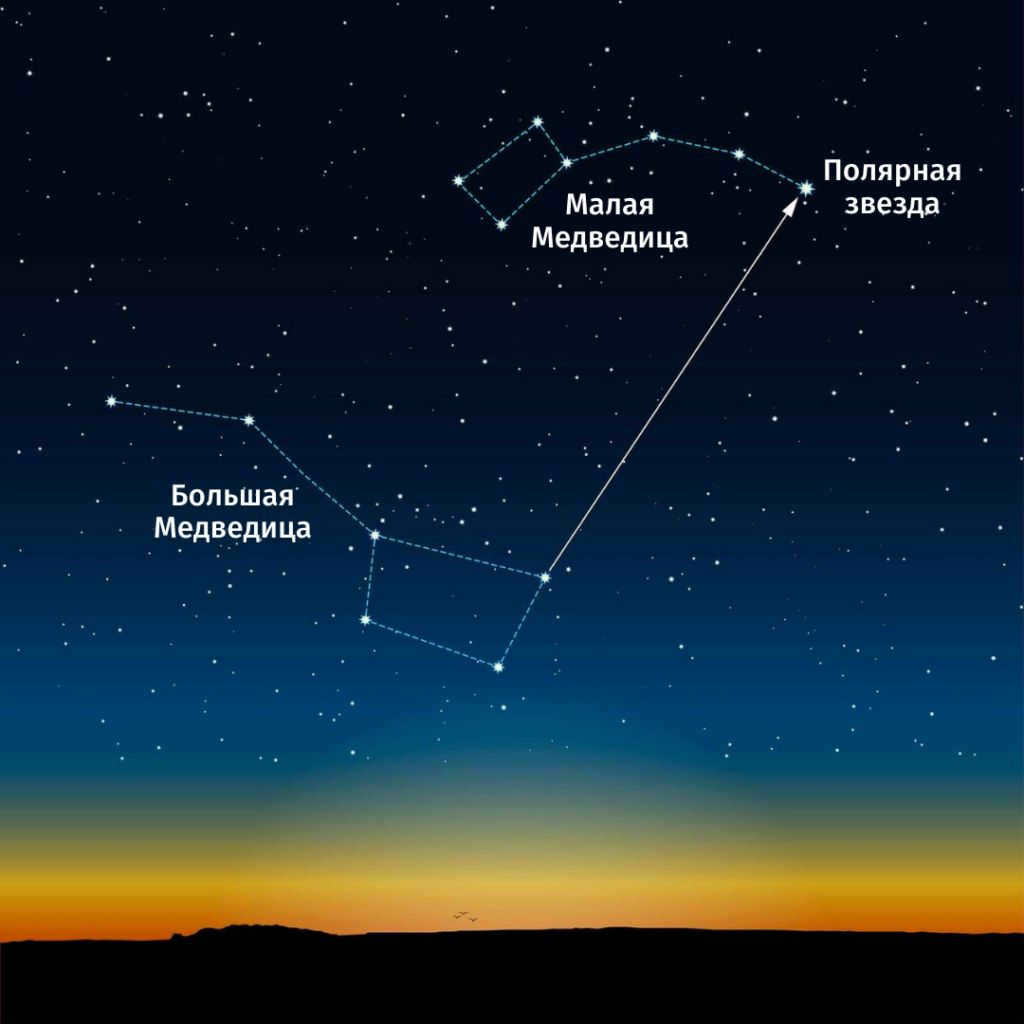
Polaris remains relatively stationary in the sky, unlike other celestial bodies that participate in the daily rotation of the celestial sphere. To be more precise, this star traces a small circle with a radius of less than one degree around a designated point known as the North Pole. If we were to draw a line from the zenith to the horizon through this point, it would indicate the direction to the north.
During the evening and morning, one can determine their orientation based on the location of the sunrise and sunset. However, this method is not entirely precise as the points of sunrise and sunset shift throughout the year. In the early morning, you should position yourself so that the right-hand side of the sky is lighter. Conversely, after sunset, the point where the sun disappears behind the horizon should be on your left. In both instances, the north will be directly in front of you, and locating Polaris is as simple as looking up. The height of Polaris above the horizon is equal to the latitude of the observation location.

Understanding the rotation of the starry sky
To comprehend the rotation of the starry sky, all you need to do is stretch your arms out to the sides and engage your imagination. You will notice that the north is in front, the south is behind, the west is on the left, and the east is on the right. If you are still unfamiliar with the surroundings, you can associate these directions with prominent objects such as trees, buildings, or bright lights on the horizon. This will allow you to understand the movement of the celestial sphere.
In reality, there is no physical celestial sphere that rotates. It is actually the Earth that revolves around the Sun and its own axis. As a result, the point on the Earth’s surface where we are located continuously changes its orientation towards various stars, which are not fixed to any specific sphere and exist at different distances from us.
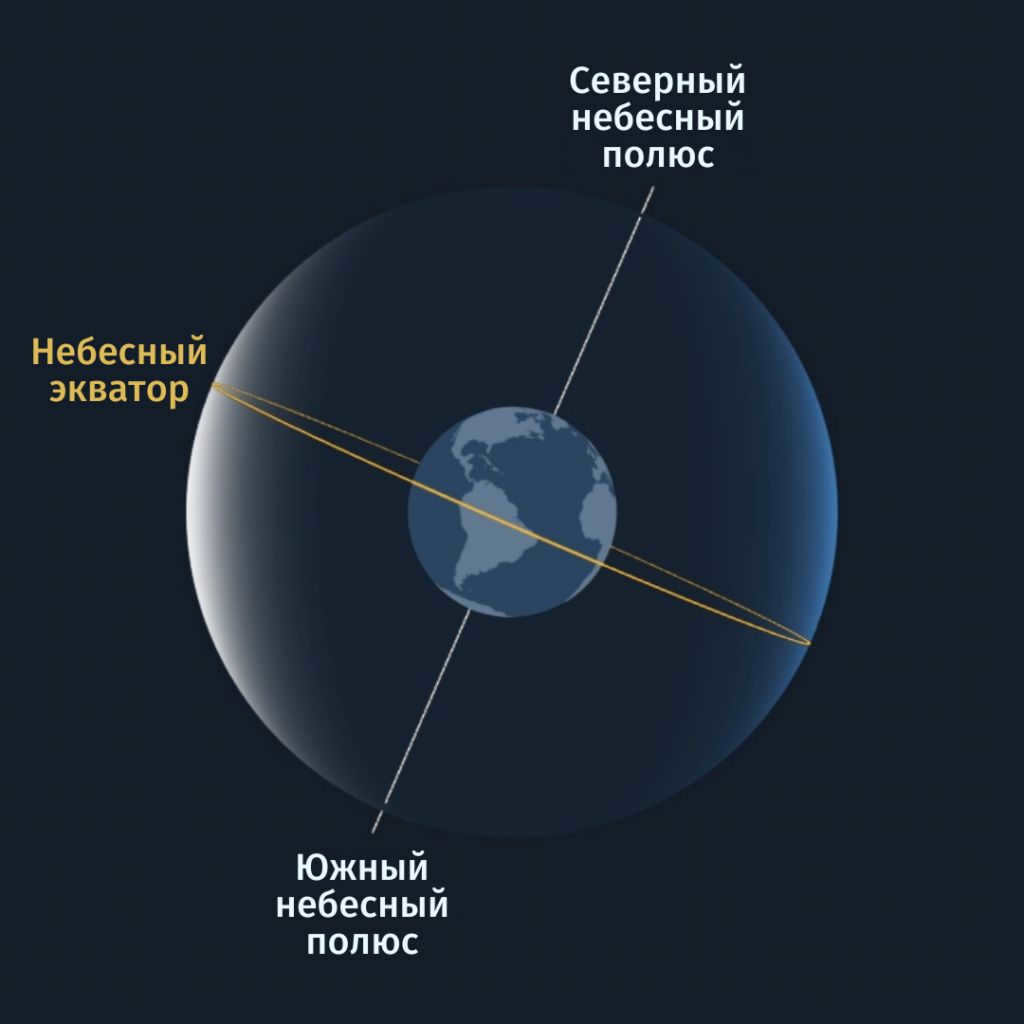

However, it is more convenient for us to envision the sky as a sphere that rotates along with the stars around an axis that precisely passes through the North Pole of the Earth. In close proximity to this axis lies Polaris (there is currently no such bright star near the South Pole). This imaginary line is known as the Earth’s axis, and throughout the day, all the stars revolve around it. In doing so, they move in the same direction as the Sun, which is clockwise. They emerge above the horizon, reach their highest point, and then descend.
The celestial equator, meridian, and stars that never set
If the celestial sphere, similar to the Earth, has an axis of rotation, it also possesses an equator known as the celestial equator. This equator is a circular line on the celestial sphere that is equidistant from both poles. Another significant circle on the celestial sphere is referred to as the celestial meridian. This meridian passes through the pole of the world and the zenith. While all stars rise above the horizon at varying heights, they all cross the celestial meridian during their daily motion. It is at this crossing point that they reach their highest point above the horizon, which is known as their culmination. It is important to note that when people mention “the Sun is at zenith,” they usually mean its culmination, indicating the local noon. However, for observers in Ukraine, the Sun never reaches the zenith.
Ecliptic and the Milky Way
The previous information pertains solely to the movement of stars. The Sun and planets, on the other hand, orbit in accordance with their own regulations and continually change position in relation to the seemingly stationary celestial bodies. This is precisely why the planets earned their name, which signifies “travelers”. Nonetheless, they also share certain characteristics.
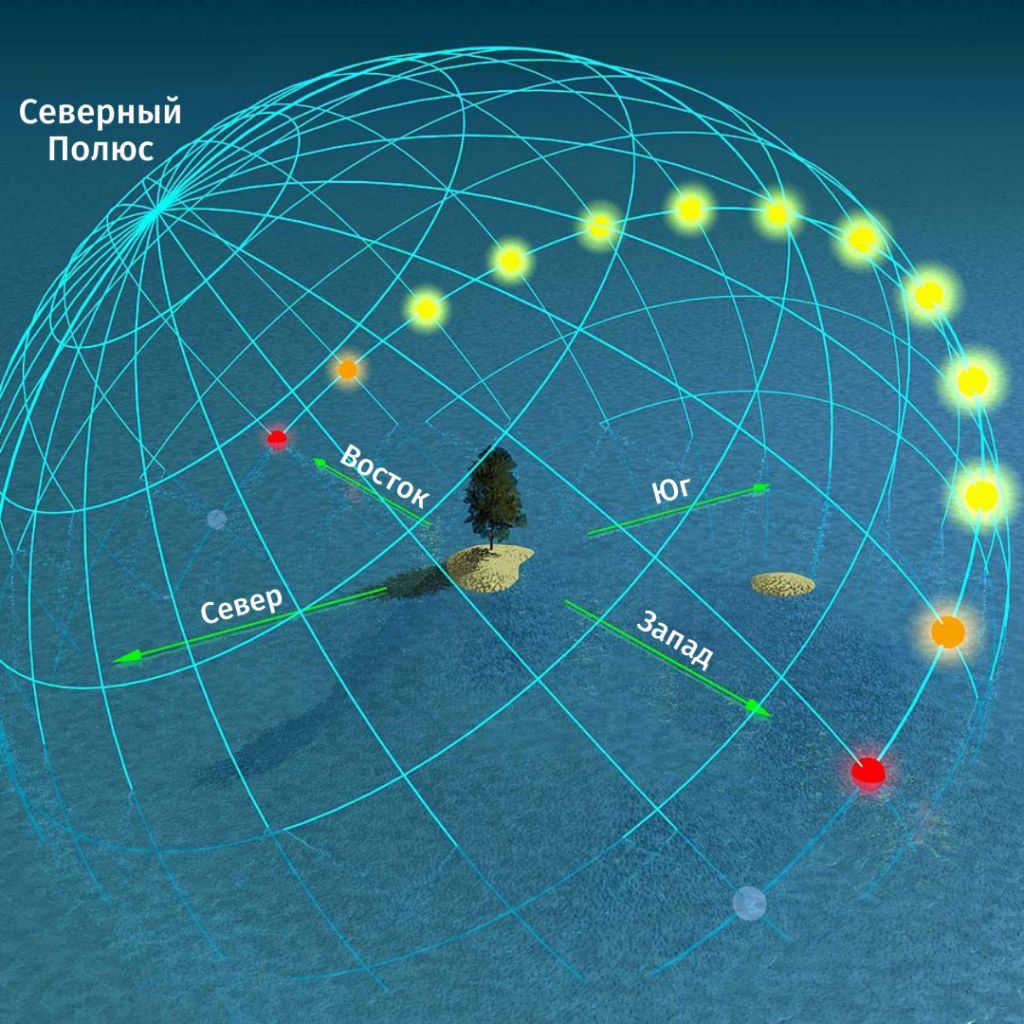
The celestial bodies, including the Moon and the planets, have a similar path across the sky, following what is known as the ecliptic. This path is a projection of the Earth’s orbit onto the celestial sphere. While the planes of other planetary orbits may deviate slightly from the ecliptic, they generally remain close to it.
One more crucial aspect of the night sky is the Milky Way – a luminous strip that wraps around the entire celestial sphere. Due to earthly factors, it is not always visible in all locations. This strip represents the plane of our Galaxy. Within the constellations of Sagittarius and Scorpius, where the strip splits into two, there is actually a galactic core concealed by dense dust clouds. This plane does not align with either the celestial equator or the ecliptic.
Local coordinate system
What is the best way to clearly indicate the location of a specific object in the heavens, ensuring that it can be easily located by other observers? The most straightforward approach is to begin with the horizon and a set direction towards one side of the globe. This is known as the horizontal coordinate system. It can also be referred to as a local coordinate system since it is linked to the precise spot where the observer is situated.
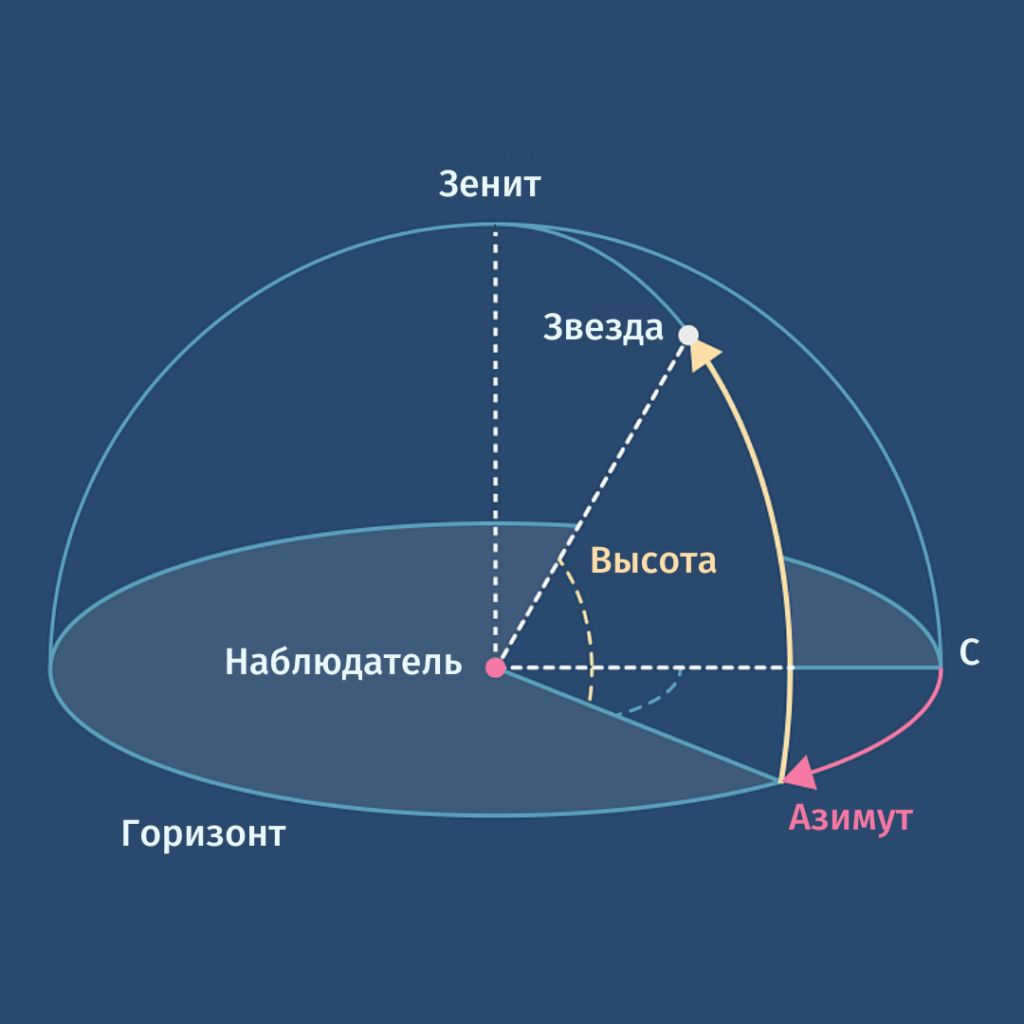
In this system, there are two coordinates for the celestial body: azimuth Az and height above the horizon h. Alternatively, you can use the zenith distance (90°-h). This determines the elevation needed for the head or telescope tube to view the object.
Azimuth (derived from the Arabic word “as-sumut” meaning “direction”) is the angle between the north point and the point where a great circle intersects the horizon, passing through the zenith and the celestial body. It is measured from left to right. In this coordinate system, north corresponds to azimuth 0°, east to 90°, south to 180°, and west to 270°.
As previously stated, the Earth rotates on its axis, causing all celestial objects to constantly shift their position in relation to the horizon. This presented a significant challenge for astronomers, leading to the development of a new system of celestial coordinates, which will be discussed in the following article.
Stay updated with the latest news and fascinating facts by joining our Telegram channel!


